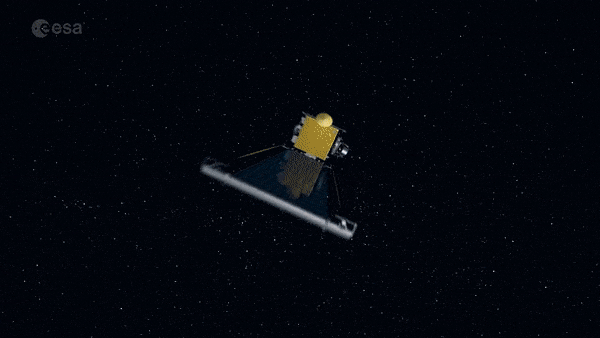How we'd really defend Earth from an asteroid attack

Caution: This post contains spoilers for Season 5 of The Expanse
The fifth season of The Expanse has delivered some of the most intense drama of the entire series—and it doesn’t even involve ancient alien tech powering up. In Season 5’s third and fourth episodes, the rocks that Belter terrorist Marco Inaros sent hurtling toward the inner solar system last season finally reach Earth.
Three of these stealth-coated asteroids strike humanity’s home world, killing millions and causing widespread destruction. But in a small victory on an otherwise dismal day, a fourth weaponized asteroid is spotted and destroyed by United Nations Navy (UNN) planetary defenses, including an orbital railgun network and nuclear missiles.
It’s a Hail Mary approach, but the basic strategy Earth uses to take out this deadly rock is similar to what scientists say we may have to do in the face of an actual cosmic catastrophe.
“The textbook response if you don't have much warning,” said Mallory DeCoster, a mechanical engineering Ph.D. candidate at the Johns Hopkins University Applied Physics Laboratory, “is going to be a balance between your civil defense mechanisms and a nuclear response.”
DeCoster is a member of NASA’s Double Asteroid Redirection Test (DART) mission team, which is spearheading the first-ever outer space test of a planetary defense strategy. The DART mission, which launches later this year, isn’t going to nuke an asteroid. Instead, scientists will be demonstrating a gentler technique we could use if we had years to prepare for an impending collision: nudging the dangerous bolide onto a different orbit by striking it with a so-called kinetic impactor.
To test this idea, NASA will be crashing a school bus-sized spacecraft into Dimorphos, a 500-foot long moonlet that orbits a larger asteroid called Didymos. The impact will alter the moonlet’s momentum enough to change the speed of its orbit around Didymos, a shift that scientists will observe using telescopes on Earth.
DeCoster says that laboratory experiments and models have given us a general sense of how to redirect an asteroid using a kinetic impactor. But doing the experiment in space, she says, is the best way to make sure our models are right and show that we can “actually leave the kind of deflection or change in orbit that is meaningful.”

If an incoming asteroid is too large to deflect—or if it’s coated in Martian stealth paint and we don’t notice it until it is on our doorstep—we may have to use the nuclear option. This is something scientists have also studied using computer models, although there are no immediate plans to test the idea in space. (Detonating nuclear devices in space is forbidden under the Outer Space Treaty of 1967.)
There are two ways that a nuke could stop an asteroid in theory. We could use it to give the rock push—like a kinetic impactor, but stronger. To do so, we’d want to detonate the nuke far enough away from the asteroid that a wide patch of the surface is irradiated with high-energy x-rays from the blast. Those x-rays would quickly heat the surface of the asteroid, causing some material to vaporize.
“Then that material will be ejected out from the asteroid and will have some momentum and the asteroid will, in turn, be pushed in the opposite direction,” said Mary Burkey, a scientist at Lawrence Livermore National Laboratory’s Planetary Defense Group who is studying this planetary defense strategy.
If we had very little warning, we might want to blast the asteroid to smithereens instead. In this case, we’d bring a nuclear device extremely close to the surface before detonating it. A shockwave would ripple through the asteroid, lots of material would be vaporized, and the fragments left behind would either sail past Earth if they were moving fast enough or burn up harmlessly in our atmosphere.
Railguns, which use electromagnetic forces to accelerate projectiles to hypersonic speeds, aren’t being seriously considered for planetary defense—outside of science fiction like The Expanse, that is. But Burkey said that in principle, a railgun could be used to lob a kinetic impactor at an asteroid and break it into smaller chunks.
This is basically what happens in “Gaugamela,” the fourth episode of Season 5. After the UNN links up its asteroid spotters and its spy satellites, Earth’s planetary defense network is able to see the asteroids Inaros and his crew disguised with Martian stealth tech. When a fourth asteroid approaches Earth after three deadly impacts, the UNN railgun network gets a lock on it and fires, shattering it into many smaller pieces.
Burkey says this initial break-up looks like something “a normal kinetic impactor could achieve.” But she warns that this would “not be a desired outcome of a normal mission, given how close the pieces were to the planet.” DeCoster agrees, saying that while this seems like a “very interesting application” for railgun technology, breaking up a big asteroid into smaller chunks when it’s so close to Earth isn’t ideal.
“You take a big risk, because if you don't know your [asteroid’s] material properties, you don't know how it's going to fracture,” she said. “The uncertainty of, are we going to break it into a million different pieces or is it just going to be two big pieces… I don't know that you can mitigate the uncertainty there unless you've done your due diligence and really characterized the targeted material beforehand.”
In this case, the UNN took a calculated risk. After the railgun network shatters Inaros’s asteroid, a military ship quickly launches a cluster of nuclear missiles, which vaporize all of the remains.
While the UNN might have simply gotten lucky that all of its nukes struck their targets, and while there may have been other unwanted consequences—DeCoster points out that a low Earth orbit nuclear detonation could knock out critical satellites—I think it’s fair to say that Earth’s government did the best that it could in an awful situation. Hopefully, the UN will learn from its shortsightedness going forward, and never doubt Chrisjen Avasarala’s warnings of impending cosmic doom ever again.
And if there’s a lesson the rest of us can take from Earth’s desperate scramble to defend itself in The Expanse, it’s that we’re better off being prepared for disasters—even very unlikely ones—than getting caught off guard as the rocks start to fall.
Top image: Amazon Studios